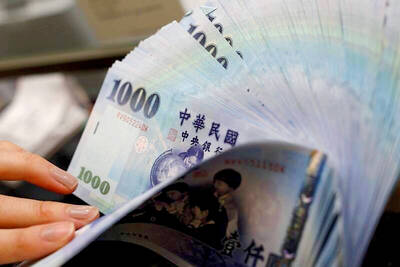Faced with layoffs and wage cuts as falling demand in the West hits the country’s vast manufacturing sector, the workers who have powered China’s breakneck growth are refusing to go quietly.
Over the past month, thousands of factory workers in China’s southern manufacturing heartlands have wrested concessions from employers facing shrinking exports and rising costs in a wave of labor unrest.
In Shenzhen, workers recently gathered at the office of labor rights organization Little Bird to debate a possible strike at a factory that employs them to demand better overtime pay and compensation.
“We have never experienced this situation. We want to learn the different methods for protecting our rights,” said Ran Lin, 30, who spends 11 hours a day, six days a week testing thousands of circuit boards on an assembly line.
Ran, who supplements his 2,000 yuan (US$315) monthly wage by working overtime at the Hong Kong-invested Dongguan Yong Jie Electronics Co Ltd factory, said the company had reduced perks such as meals and housing, even as the cost of living rose.
“We made contributions to economic development. We gave so much to the company. I hope they can give us suitable compensation,” Ran said.
As a manufacturing slowdown forces employers to cut back on benefits and lay off staff, workers are reaching out to grassroots groups, such as Little Bird, and even -government-linked agencies that offer legal advice and address complaints.
“Workers’ recognition of protecting their rights has increased. They have learned to unify,” Little Bird founder Wei Wei said.
Wei said the dense concentration of factories in China’s Guangdong Province had helped to spread news of the strikes, which emboldened workers.
Thousands of workers in Guangdong and elsewhere downed tools last month as factories hit by slowing demand in the US and Europe passed the pressure of rising costs and falling orders on to staff.
China’s manufacturing activity contracted last month for the first time in 33 months, as the export-led economic growth moderated to 9.1 percent in the third quarter from 9.5 percent in the previous quarter due to falling demand.
The Chinese Communist Party fears an independent labor movement could threaten its grip on power, so it only allows only one, government-linked trade union.
However, activists say government officials have been more sympathetic to individual grievances against factories, especially those funded by foreign firms or investors from Taiwan and Hong Kong.
“The government is afraid of simmering grievances. They don’t want workers to go on the streets or to demand trade unions,” said Debby Chan of Hong Kong-based Students and Scholars Against Corporate Misbehaviour.
Authorities have addressed concerns of workers by giving more teeth to a revised labor contract law, consulting industry groups and allowing courts to handle disputes.
And in an apparent response to recent unrest, authorities in Shenzhen recently announced plans to hike the minimum wage by 14 percent to 1,500 yuan per month from January, following a 20 percent rise in April.
Geoffrey Crothall, a spokesperson for the Hong Kong-based China Labour Bulletin, said some of the recent action showed a new level of sophistication.
He cited the example of workers at five PepsiCo bottling plants across the country who protested on the same day after the US beverage giant sold its plants in China.
“That is a level of organization that we’ve not really seen before, in terms of coordination of factories in different parts of China,” Crothall said.
In strikes last year against Japanese companies, workers cloaked their protests in anti-Japanese rhetoric to make them more acceptable to the government.
“They know it’s a motivating tool to get people on their side. Chinese workers are quite politically savvy,” Crothall added.
At a Shenzhen factory owned by Hong Kong women’s underwear maker Top Form International, last month hundreds of workers refused to return to their sewing machines for several days until management paid every worker 1,000 yuan.
“They swear at us. They never give us overtime. Why should we work?” one of the strikers said outside the aging green factory building.
Another two-week strike last month by nearly 1,000 workers, which paralyzed a Shenzhen factory invested by Japanese watchmaker Citizen Watch Co, revolved around rest breaks.
Managers made employees work additional time without pay to make up for breaks, which lasted 15 minutes every two hours, workers said. They returned after talks negotiated 70 percent pay for the rest periods.
Deng Shiping, who joined a strike of thousands against a -Taiwan-invested electronics factory last year, said organizing was made easier since everyone lived together in dormitories — a typical arrangement for migrant workers.
Workers chose representatives to inform other shifts and departments about the planned strike.
“There was no leader, it was us — the workers — all together,” he said.

Merida Industry Co (美利達) has seen signs of recovery in the US and European markets this year, as customers are gradually depleting their inventories, the bicycle maker told shareholders yesterday. Given robust growth in new orders at its Taiwanese factory, coupled with its subsidiaries’ improving performance, Merida said it remains confident about the bicycle market’s prospects and expects steady growth in its core business this year. CAUTION ON CHINA However, the company must handle the Chinese market with great caution, as sales of road bikes there have declined significantly, affecting its revenue and profitability, Merida said in a statement, adding that it would

MARKET LEADERSHIP: Investors are flocking to Nvidia, drawn by the company’s long-term fundamntals, dominant position in the AI sector, and pricing and margin power Two years after Nvidia Corp made history by becoming the first chipmaker to achieve a US$1 trillion market capitalization, an even more remarkable milestone is within its grasp: becoming the first company to reach US$4 trillion. After the emergence of China’s DeepSeek (深度求索) sent the stock plunging earlier this year and stoked concerns that outlays on artificial intelligence (AI) infrastructure were set to slow, Nvidia shares have rallied back to a record. The company’s biggest customers remain full steam ahead on spending, much of which is flowing to its computing systems. Microsoft Corp, Meta Platforms Inc, Amazon.com Inc and Alphabet Inc are

RISING: Strong exports, and life insurance companies’ efforts to manage currency risks indicates the NT dollar would eventually pass the 29 level, an expert said The New Taiwan dollar yesterday rallied to its strongest in three years amid inflows to the nation’s stock market and broad-based weakness in the US dollar. Exporter sales of the US currency and a repatriation of funds from local asset managers also played a role, said two traders, who asked not to be identified as they were not authorized to speak publicly. State-owned banks were seen buying the greenback yesterday, but only at a moderate scale, the traders said. The local currency gained 0.77 percent, outperforming almost all of its Asian peers, to close at NT$29.165 per US dollar in Taipei trading yesterday. The

The US overtaking China as Taiwan’s top export destination could boost industrial development and wage growth, given the US is a high-income economy, an economist said yesterday. However, Taiwan still needs to diversify its export markets due to the unpredictability of US President Donald Trump’s administration, said Chiou Jiunn-rong (邱俊榮), an economics professor at National Central University. Taiwan’s exports soared to a record US$51.74 billion last month, driven by strong demand for artificial intelligence (AI) products and continued orders, with information and communication technology (ICT) and audio/video products leading all sectors. The US reclaimed its position as Taiwan’s top export market, accounting for